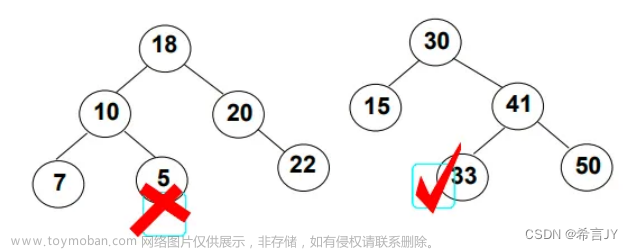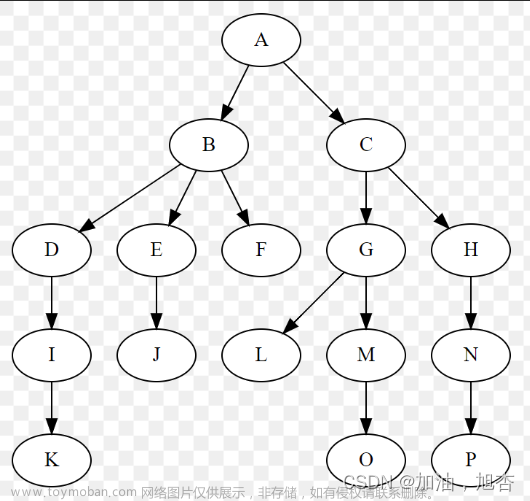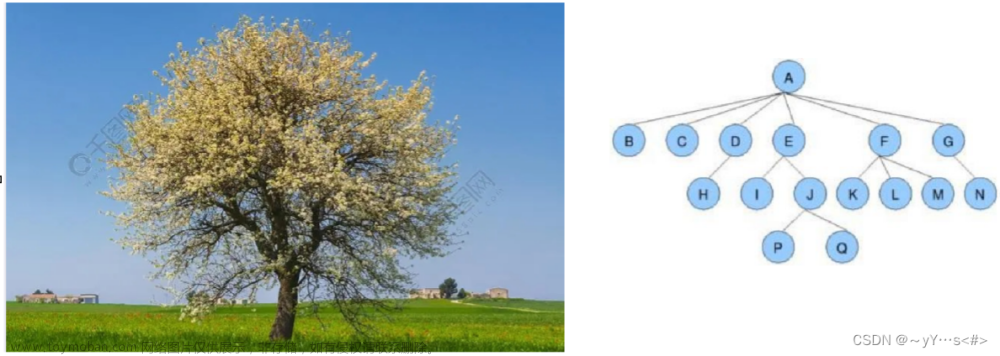目录
1.二叉树的最大深度
2.相同的树
3.另一棵树的子树
4.翻转二叉树
5.平衡二叉树
6.对称二叉树
7.完全二叉树
8.二叉树遍历
9.层序遍历
10.根据中序和前序序列构造二叉树
11.根据中序和后序序列构造二叉树
12.二叉树的最近公共祖先
13.非递归前序遍历
14.非递归中序遍历
15.非递归后序遍历
16.二叉树创建字符串
public class TreeNode {
int val;
TreeNode left;
TreeNode right;
TreeNode() {}
TreeNode(int val) { this.val = val; }
TreeNode(int val, TreeNode left, TreeNode right) {
this.val = val;
this.left = left;
this.right = right;
}
}1.二叉树的最大深度
二叉树的最大深度
class Solution {
public int maxDepth(TreeNode root) {
if (root == null) {
return 0;
}
int leftH = maxDepth(root.left);
int rightH = maxDepth(root.right);
return (leftH > rightH ? leftH: rightH) + 1;
}
}2.相同的树
相同的树
时间复杂度O(min(m, n)),其中m,n为两棵树的结点个数。
class Solution {
public boolean isSameTree(TreeNode p, TreeNode q){
//结构不同
if (p == null && q != null || p != null && q== null) {
return false;
}
//结构相同
if (p == null && q == null) {
return true;
}
//存储的值不同
if (p.val != q.val) {
return false;
}
return isSameTree(p.left,q.left) && isSameTree(p.right,q.right);
}
}3.另一棵树的子树
另一棵树的子树
时间复杂度O( |s|x|t| ),其中s为主树结点数,t为子树结点数。
class Solution {
public boolean isSameTree(TreeNode p, TreeNode q){
//结构不同
if (p == null && q != null || p != null && q == null) {
return false;
}
//结构相同
if (p == null && q == null) {
return true;
}
//存储的值不同
if (p.val != q.val) {
return false;
}
return isSameTree(p.left,q.left) && isSameTree(p.right,q.right);
}
public boolean isSubtree(TreeNode root, TreeNode subRoot) {
if (root == null) {
return false;
}
if (isSameTree(root,subRoot)) {
return true;
}
if (isSubtree(root.left,subRoot)) {
return true;
}
if (isSubtree(root.right,subRoot)) {
return true;
}
return false;
}
}4.翻转二叉树
翻转二叉树
class Solution {
public TreeNode invertTree(TreeNode root) {
if (root == null) {
return null;
}
TreeNode tmp = null;
tmp = root.left;
root.left = root.right;
root.right = tmp;
invertTree(root.left);
invertTree(root.right);
return root;
}
}5.平衡二叉树
平衡二叉树
法一:
class Solution {
public int maxDepth(TreeNode root) {
if (root == null) {
return 0;
}
int leftH = maxDepth(root.left);
int rightH = maxDepth(root.right);
return (leftH > rightH ? leftH: rightH) + 1;
}
//时间复杂度 O(n^2)
public boolean isBalanced(TreeNode root) {
if (root == null) {
return true;
}
int leftHeight = maxDepth(root.left);
int rightHeight = maxDepth(root.right);
return Math.abs(leftHeight-rightHeight) < 2
&& isBalanced(root.left)
&& isBalanced(root.right);
}
}法二:
class Solution {
public int maxDepth(TreeNode root) {
if (root == null) {
return 0;
}
int leftH = maxDepth(root.left);
int rightH = maxDepth(root.right);
if (leftH >= 0 && rightH >=0
&& Math.abs(leftH-rightH) <= 1) {
return Math.max(leftH,rightH) + 1;
}else {
return -1;
}
}
//时间复杂度 O(n)
public boolean isBalanced(TreeNode root) {
if (root == null) {
return true;
}
return maxDepth(root) >= 0;
}
}6.对称二叉树
对称二叉树
class Solution {
public boolean isSymmetricChild(TreeNode leftTree,TreeNode rightTree) {
if (leftTree == null && rightTree != null
|| leftTree != null && rightTree == null) {
return false;
}
if (leftTree == null && rightTree == null) {
return true;
}
if (leftTree.val != rightTree.val) {
return false;
}
return isSymmetricChild(leftTree.left,rightTree.right)
&& isSymmetricChild(leftTree.right,rightTree.left);
}
public boolean isSymmetric(TreeNode root) {
if (root == null) {
return true;
}
return isSymmetricChild(root.left,root.right);
}
}7.完全二叉树
判断是否为完全二叉树,没有找到链接o.O
class Solution {
public boolean isCompleteTree(TreeNode root) {
Queue<TreeNode> queue = new LinkedList<>();
if (root != null) {
queue.offer(root);
}
while (!queue.isEmpty()) {
TreeNode top = queue.poll();
if (top != null) {
queue.offer(top.left);
queue.offer(top.right);
}else {
break;
}
}
while (!queue.isEmpty()) {
TreeNode cur = queue.poll();
if (cur != null) {
return false;
}
}
return true;
}
}8.二叉树遍历
二叉树遍历
注意这题 TreeNode 中的 val 要改为char类型。
public class Main {
public static void main(String[] args) {
Scanner in = new Scanner(System.in);
while (in.hasNextLine()) {
String str = in.nextLine();
TreeNode root = createTree(str);
inOrder(root);
}
}
public static int i = 0;
public static TreeNode createTree(String str) {
TreeNode root = null;
if (str.charAt(i) != '#') {
root = new TreeNode(str.charAt(i));
i++;
root.left = createTree(str);
root.right = createTree(str);
}else {
i++;
}
return root;
}
public static void inOrder(TreeNode root) {
if (root == null) {
return;
}
inOrder(root.left);
System.out.print(root.val+" ");
inOrder(root.right);
}
}9.层序遍历
层序遍历
class Solution {
//层序遍历:利用队列
//法一:有返回值
public List<List<Integer>> levelOrder(TreeNode root) {
List<List<Integer>> ret = new ArrayList<>();
if (root == null) {
return ret;
}
Queue<TreeNode> queue = new LinkedList<>();
queue.offer(root);
while (!queue.isEmpty()) {
int size = queue.size();
List<Integer> list = new ArrayList<>();
while (size != 0) {
TreeNode top = queue.poll();
list.add(top.val);
if (top.left != null) {
queue.offer(top.left);
}
if (top.right != null) {
queue.offer(top.right);
}
size--;
}
ret.add(list);
}
return ret;
}
//法二:无返回值
public void levelOrder2(TreeNode root) {
Queue<TreeNode> queue = new LinkedList<>();
if (root != null) {
queue.offer(root);
}
while (!queue.isEmpty()) {
TreeNode top = queue.poll();
System.out.print(top.val + " ");
if (top.left != null) {
queue.offer(top.left);
}
if (top.right != null) {
queue.offer(top.right);
}
}
}
}10.根据中序和前序序列构造二叉树
根据中序和前序序列构造二叉树
class Solution {
public int preIndex = 0;
public TreeNode buildTree(int[] preorder, int[] inorder) {
return buildTreeChild(preorder, inorder, 0, inorder.length-1);
}
private TreeNode buildTreeChild(int[] preorder,int[] inorder,int inbegin,int inend) {
//递归的出口,不满足条件说明没有左树或右树
if (inbegin > inend) {
return null;
}
//创建根结点
TreeNode root = new TreeNode(preorder[preIndex]);
//在中序序列中找到根结点所在的位置
int rootIndex = findIndex(inorder,inbegin,inend,preorder[preIndex]);
preIndex++;
//创建左右树
root.left = buildTreeChild(preorder,inorder,inbegin,rootIndex-1);
root.right = buildTreeChild(preorder,inorder,rootIndex+1,inend);
return root;
}
//在中序序列中找到根结点所在的位置
private int findIndex(int[] inorder, int inbegin, int inend, int key) {
for (int i = inbegin; i <= inend ; i++) {
if (inorder[i] == key) {
return i;
}
}
return -1;
}
}11.根据中序和后序序列构造二叉树
根据中序和后序序列构造二叉树
class Solution {
public int postIndex = 0;
public TreeNode buildTree(int[] inorder, int[] postorder) {
postIndex = postorder.length-1;
return buildTreeChild(postorder, inorder, 0, inorder.length-1);
}
private TreeNode buildTreeChild(int[] postorder,int[] inorder,int inbegin,int inend) {
//递归的出口,不满足条件说明没有左树或右树
if (inbegin > inend) {
return null;
}
//创建根结点
TreeNode root = new TreeNode(postorder[postIndex]);
//在中序序列中找到根结点所在的位置
int rootIndex = findIndex(inorder,inbegin,inend,postorder[postIndex]);
postIndex--;
//创建右左树
root.right = buildTreeChild(postorder,inorder,rootIndex+1,inend);
root.left = buildTreeChild(postorder,inorder,inbegin,rootIndex-1);
return root;
}
//在中序序列中找到根结点所在的位置
private int findIndex(int[] inorder, int inbegin, int inend, int key) {
for (int i = inbegin; i <= inend ; i++) {
if (inorder[i] == key) {
return i;
}
}
return -1;
}
}12.二叉树的最近公共祖先
二叉树的最近公共祖先
法一:搜索二叉树
class Solution {
public TreeNode lowestCommonAncestor(TreeNode root, TreeNode p, TreeNode q) {
if (root == null) {
return null;
}
if (p == root || q == root) {
return root;
}
TreeNode leftRet = lowestCommonAncestor(root.left,p,q);
TreeNode rightRet = lowestCommonAncestor(root.right,p,q);
if (leftRet != null && rightRet != null) {
return root;
}else if (leftRet != null) {
return leftRet;
}else {
return rightRet;
}
}
}法二:链表相交+栈
class Solution {
public TreeNode lowestCommonAncestor(TreeNode root, TreeNode p, TreeNode q) {
if (root == null) {
return null;
}
Stack<TreeNode> s1 = new Stack<>();
getPath(root,p,s1);
Stack<TreeNode> s2 = new Stack<>();
getPath(root,q,s2);
int size1 = s1.size();
int size2 = s2.size();
if (size1 > size2) {
int size = size1 - size2;
while (size != 0) {
s1.pop();
size--;
}
}else {
int size = size2 - size1;
while (size != 0) {
s2.pop();
size--;
}
}
while (!s1.empty() && !s2.empty()) {
TreeNode tmp1 = s1.pop();
TreeNode tmp2 = s2.pop();
if (tmp1 == tmp2) {
return tmp1;
}
}
return null;
}
//获取root这棵树下node所在结点的路径
public boolean getPath(TreeNode root, TreeNode node, Stack<TreeNode> stack) {
if (root == null) {
return false;
}
stack.push(root);
if (root == node) {
return true;
}
boolean ret = getPath(root.left,node,stack);
if (ret == true) {
return true;
}
boolean ret2 = getPath(root.right,node,stack);
if (ret2 == true) {
return true;
}
stack.pop();
return false;
}
}
}
13.非递归前序遍历
非递归前序遍历
class Solution {
public void preOrder(TreeNode root) {
if (root == null) {
return;
}
Stack<TreeNode> stack = new Stack<>();
TreeNode cur = root;
while (cur != null || !stack.empty()) {
while (cur != null) {
stack.push(cur);
System.out.print(cur.val+" ");
cur = cur.left;
}
TreeNode top = stack.pop();
cur = top.right;
}
}
}14.非递归中序遍历
非递归中序遍历
class Solution {
public void inOrder(TreeNode root) {
if (root == null) {
return;
}
Stack<TreeNode> stack = new Stack<>();
TreeNode cur = root;
while (cur != null || !stack.empty()) {
while (cur != null) {
stack.push(cur);
cur = cur.left;
}
TreeNode top = stack.pop();
System.out.print(cur.val+" ");
cur = top.right;
}
}
}15.非递归后序遍历
非递归后序遍历文章来源:https://www.toymoban.com/news/detail-500604.html
class Solution {
public void postOrder(TreeNode root) {
if (root == null) {
return;
}
Stack<TreeNode> stack = new Stack<>();
TreeNode cur = root;
TreeNode prev = null;
while (cur != null || !stack.empty()) {
while (cur != null) {
stack.push(cur);
cur = cur.left;
}
TreeNode top = stack.peek();
if (top.right == null || top.right == prev) {
System.out.println(top.val+" ");
prev = top;
stack.pop();
}else {
cur = top.right;
}
}
}
}16.二叉树创建字符串
二叉树创建字符串文章来源地址https://www.toymoban.com/news/detail-500604.html
class Solution {
public String tree2str(TreeNode root) {
StringBuilder stringBuilder = new StringBuilder();
tree2strChild(root,stringBuilder);
return stringBuilder.toString();
}
public void tree2strChild(TreeNode root,StringBuilder stringBuilder) {
if (root == null) {
return;
}
stringBuilder.append(root.val);
if (root.left != null) {
stringBuilder.append("(");
tree2strChild(root.left,stringBuilder);
stringBuilder.append(")");
}else {
if (root.right == null) {
return;
}else {
stringBuilder.append("()");
}
}
if (root.right != null) {
stringBuilder.append("(");
tree2strChild(root.right,stringBuilder);
stringBuilder.append(")");
}else {
return;
}
}
}
到了这里,关于【数据结构】二叉树面试题的文章就介绍完了。如果您还想了解更多内容,请在右上角搜索TOY模板网以前的文章或继续浏览下面的相关文章,希望大家以后多多支持TOY模板网!












